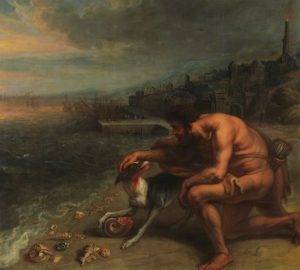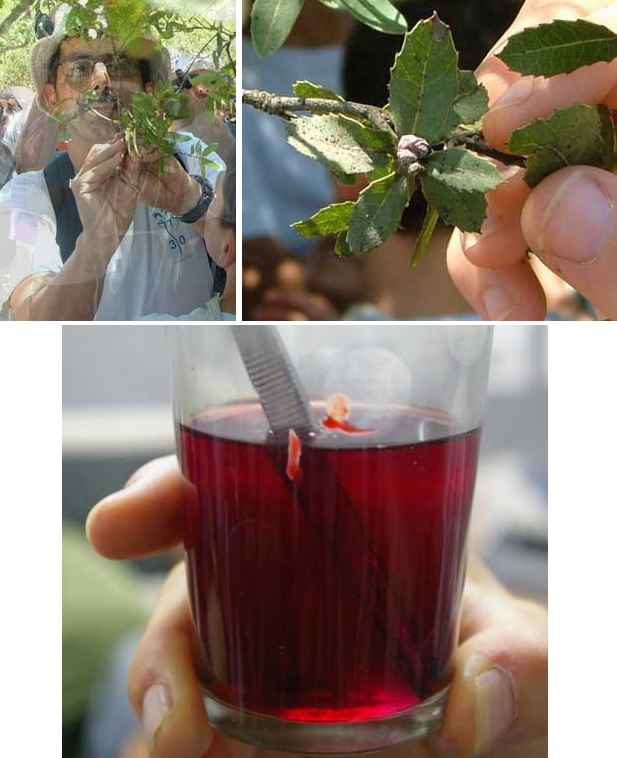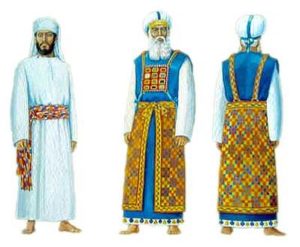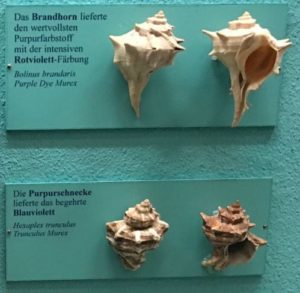In recent years, psychedelic substances have entered the mainstream and many people have begun using Ayahuasca, DMT, psilocybin, peyote, and other “plant medicines” for healing and overcoming traumas. What is the Jewish approach to such psychedelics? What can we learn about them from the Torah, and from the procedures of the kohen gadol on Yom Kippur? How do we address the risks and dangers surrounding these drugs? And is there any connection to avodah zarah or idolatry in ceremonies that make use of these substances? Find out in this fascinating podcast where we also discuss “snake energy” and kundalini, yoga and astronomy, and what role plant medicines might play in the forthcoming Messianic Age.
Tag Archives: Priestly Vestments
How the Priestly Garments Atoned for the People
This week’s parasha, Pekudei, describes how the Mishkan and all of its vessels were created, together with the special priestly garments. The parasha ends with the formal initiation of Aaron and his sons into the priesthood through their ritual purification, anointment, and donning of the sacred vestments. Our Sages famously state (Zevachim 88b) that the vestments of the Kohen Gadol, the High Priest, atoned for the sins of the people:
The tunic atoned for bloodshed… the breeches atoned for lewdness… the turban made atonement for arrogance… the belt atoned for [impure] meditations of the heart… the breastplate atoned for neglect of civil laws… the apron atoned for idolatry… the cloak atoned for slander… and the crown, worn on the forehead, atoned for brazenness.
The tunic (kutonet) was a simple white garment worn over the body which all of the priests (not only the High Priest) wore. The Talmud says it atoned for bloodshed, and proves it through a gzerah shavah, a form of interpretation where the exact same word (or root of a word) appears in two different contexts, thus allowing a connection between the two to be made. In Genesis 37:31 we read how, following the sale of Joseph, his brothers slaughtered a goat and dipped Joseph’s special robe in the goat’s blood. They used the bloodied robe as proof to show their father Jacob that Joseph had been murdered or devoured by an animal. The word used for Joseph’s robe is kutonet, too, that same word used for the Kohen’s garment. From this we can learn that the kutonet atoned for bloodshed.
The breeches (michnasei bad) were white pants worn to cover up the lower half of the body, and atoned for sexual immorality. The Talmud proves it from an explicit verse in the Torah (Exodus 28:42) where God commanded that the pants be made “to cover up the flesh of their nakedness”. The Hebrew term here is precisely the one used to denote sexual indecency (‘ervah, or gilui arayot).
The white turban (mitznefet) atones for arrogance. Rabbi Hanina explains here that the turban was worn on the head at the very top of the body, and thus atoned for people who similarly put themselves “at the head” above other people.
The last of the four garments worn by the regular priest is the avnet, a sash or belt. Made of red, blue, and purple wool, it was the only multi-coloured garment worn by the regular priest. It atoned for impure thoughts, and the Talmud says we know this from the fact that the sash was worn tied around the heart. Contrary to what we may expect, this was not a belt to hold up the pants, but rather an independent garment wrapped around the upper body.
In Jewish thought, the heart is the seat of the yetzer hara, the evil inclination, which tries to make a person sin by throwing improper thoughts into their head. The heart is also the seat of the yetzer hatov, the good inclination. These two opposing forces both reside in one’s heart. Because of this, the term for “heart” used in the daily Shema is levavecha, and not the more grammatically consistent libecha. The former has an extra letter beit, the doubled language alluding to the two inclinations in the heart.
Our Sages teach that one should always keep their mind above their heart, in full control of their inclinations. The brain should dominate the heart, and the heart should dominate the liver. The Hebrew word for liver, kaved (כבד), is directly related to kavod (כבוד), “honour”. Thus, the liver is the source of pride and arrogance. These organs are arranged physiologically in the body the way they are to teach us a lesson: the brain (or intellect) should be on top, then the emotions of the heart below it, and the ego at the very bottom.
If one accomplishes this, with their brain, moach (מוח) in Hebrew, being above their heart, lev (לב), and their heart being above their liver, kaved (כבד)—then they become a melekh (מלך), “king”. If the letters are reversed, where one’s honour trumps their emotions, which in turn overrule their reasoning, then they are klum (כלם), “nothing”.
The Four Garments of the High Priest
The High Priest wore an additional four unique garments. On his forehead was the golden plate known as the tzitz, which atoned for brazenness. This is proven by another gzerah shavah between Exodus 28:38, which commands the priest to wear the plate upon his metzach, “forehead”, and Jeremiah 3:3 which speaks of the brazen “forehead” (again metzach) of a licentious woman.
On top of the regular white tunic, the High Priest wore a meil, a “coat” made entirely of fine blue (tekhelet) wool. The coat atoned for lashon hara, evil speech. Since the Torah states that the coat had bells along its bottom, which jingled as the Kohen walked, Rabbi Hanina explains: “Let an article of sound come and atone for an offence of sound.”
Rav Yitzchak Ginsburgh points out that the term for bell, pa’amon (פעמן) refers to something that resonates, and the same root is used, for example, in describing how the Spirit of God resonated within—l’fa’amo (לפעמו)—the Biblical judge Samson (Judges 13:25). Rav Ginsburgh beautifully notes how the gematria of “Spirit of God” (רוח ה׳) is 240, equal to that of pa’amon (פעמן). It is also equal to meil ha’ephod (מעיל האפד), the full title of the garment, as in Exodus 29:5 or 39:22. He concludes that if one wishes to have the Spirit of God rest upon them, the key is to refrain from any evil speech.
The ephod, or apron, atoned for idolatry. This is derived from Hosea 3:4: “For the children of Israel shall sit solitary many days without king, and without prince, and without sacrifice, and without pillar, and without ephod or teraphim.” The verse is taken to mean that where there is no ephod, there will be teraphim—various implements of idol worship. The word “teraphim” appears multiple times in the Tanakh (as in Genesis 31:19 and Judges 17:5), nearly always in relation to idolatry.
Upon the ephod was the famous choshen, the breastplate that, according to tradition, allowed for communication with the Heavens. The breastplate atoned for violations of dinin, civil law. We know this from the fact that the Torah calls the breastplate choshen mishpat (Exodus 28:15), literally “breastplate of judgement”, with the term mishpat typically referring to court cases and civil law (whereas chukim and edot refer to religious-based, historical, or ritual laws).
In this way, even the very clothes of the Kohen helped him fulfill his main duty of bringing atonement for the people. Yet, in the past two thousand years, there has been no Temple and no priestly service. Might there be something in its stead?
Every Jew is a Priest
When the Temple was destroyed, our Sages instituted a number of practices in place of those Temple rituals. They declared that “as long as the Temple stood, the altar atoned for Israel, but now a man’s table atones for him” (Berakhot 55a). Just as the priests would wash their hands in a special basin before starting their services (and before eating terumah), the Rabbis instituted netilat yadayim, the ritual washing of the hands before starting a meal. Just as the sacrificial meat was required to be brought with salt, it became customary to dip the bread in salt before eating it. In place of the Temple menorah we have the Chanukah menorah, and in place of the Temple showbread we have two challahs, each traditionally braided with six strands to represent the twelve loaves once displayed in the Temple.
In many ways, the Talmudic sages and rabbis saw themselves filling the role once held by the ancient priests. More importantly, they taught that every righteous Jew should see himself as a priest. After all, God intended for all of Israel to be a “kingdom of priests and a holy nation” (Exodus 19:6). In fact, many commentaries agree that it is only because of the Golden Calf incident that the tribe of Levi was appointed to take over the priesthood. Were it not for that tragedy, every firstborn male would be a priest, and any other Jewish male could voluntarily enter the priesthood. To this effect, the Talmud (Bava Kamma 38a) goes so far as to state that “even a non-Jew who occupies himself with Torah is comparable to the High Priest.” A person who lives in Torah and refines himself to the highest degree is likened to the greatest of priests, at least in a spiritual sense.
In a wonderful affirmation of this, we see that every Torah-observing Jewish man is wearing “holy garments” that parallel the priestly vestments. Everyone generally wears a shirt and pants with a belt, along with their head-covering, corresponding to the four vestments of the regular priest (kutonet, michnasei bad, avnet, mitznefet). And there are four additional special items that a Jew wears that parallel those unique garments of the High Priest:
The tzitz headplate worn on the top of the forehead is like the head tefillin worn “between the eyes”, while the choshen breastplate worn over the heart is like the arm tefillin which is supposed to be worn in line with the heart. The ephod that was worn over the shoulders and stretched down below the waist is like the tzitzit katan garment worn over the shoulders with its fringes hanging down below the waist. The woolen tallit with which we wrap ourselves, with its customary blue stripes to remember tekhelet, is like the special blue meil that was made of fine tekhelet wool. And just as the meil had pa’amonim bells along its hem, the tallit, too, customarily has bell-like knots along its hem.
In this way, every Jew has the ability to elevate to a priest-like status, especially in lieu of a Temple, and in light of the Torah’s statement that all of Israel is a “nation of priests” (Exodus 19:6). Each Jew can bring about atonement, not only for himself but for his people as a whole, and each Jew can spread evermore divine light into the world.
What is Tekhelet?
At the beginning of this week’s parasha, Tetzave, the Torah describes the special garments worn by the Kohanim. Making these garments requires the use of three unique dyed fabrics: tekhelet, argaman, v’tola’at shani, “blue, purple, and crimson wool”. Last year, we discussed tola’at shani and the practice of wearing a red string on the wrist. This year we will explore the other two ingredients: tekhelet and argaman. What are they and where do they come from?

In Greek mythology, the hero Hercules discovered Tyrian purple when his dog chewed on sea snails, as depicted here in Peter Paul Rubens’ “Hercules’ Dog Discovers Purple Dye”
Argaman is more commonly known as “Tyrian purple” or “royal purple”, a famous and prized dye in ancient times. Historical records and archaeological findings show that as early as 3500 years ago, trade in Tyrian purple was widespread across the Mediterranean and the Middle East. It was the Phoenicians who were experts in its production, and carried it around the region. (In fact, the root of the term Phoenician means “purple” in Greek. Similarly, some scholars have found evidence that Canaan means “dye merchant”.) Tyrian purple was worth at least as much as silver, and in some points in history, more than gold.
By the Roman Era, it was so expensive and prized that it was essentially only worn by royalty, hence “royal purple”. An average Roman, or even a Roman senator, would wear a toga pura, plain white, while magistrates and priests wore a toga praetexta, with a purple stripe or hem. Only the emperor would wear a toga picta, one that was entirely dyed purple, with gold embroidery. (Such a toga might also be worn by high ranking generals during their victory processions, as well as by the consuls.)
How did the Phoenicians produce argaman? It was extracted from the glands of shellfish on the Phoenician shores of the Eastern Mediterranean. These Murex snails make the dye as a defense mechanism, spraying it on potential predators (just as squids and octopuses, their mollusc relatives, famously do). Research shows that the snails also use the dye for their own predatory behaviour when catching prey, and also as an antimicrobial to protect their eggs. To extract the dye, the snails are either “milked”, which takes a very long time, or more commonly, pierced through their shells to have the glands removed. It would take over 10,000 snails to produce just a few grams of dye!
Tekhelet was made the same way. Though not nearly as popular in ancient times, it was known as “royal blue”. The Phoenicians made it the same way, extracted from a snail. Some say it was derived from a different species of snail, while others point out that the same Tyrian purple, when exposed to large amounts of UV radiation (sunlight), becomes blue.
The Talmud (Menachot 44a) states that the dye was made from chilazon, a snail “whose body resembles the sea, and its form resembles a fish, and it comes up once in seventy years, and with its blood one dyes tekhelet, and therefore its blood is expensive.” It’s not quite the blood of the snail that makes the dye, of course, nor do the snails emerge only once in seventy years. This bit probably entered the Talmud because by that point in history, tekhelet production among Jews had long ended, and knowledge of its exact extraction forgotten. It was probably difficult, if not entirely impossible, for Jews to get their hands on it.
Dr. Baruch Sterman, in a paper for B’Or HaTorah (vol. 11, pg. 185), points out that by the 4th century CE it was actually a crime for a commoner to wear tekhelet across the Roman world. It is highly likely that it was then, for this reason, that most Jews stopped using tekhelet in their tzitzit. Dr. Sterman brings proof from the Talmud (Sanhedrin 12a), where we read how two rabbis were arrested by the Romans for possessing tekhelet. Wealthy Jews living in the Persian Empire continued to pay exorbitant rates to import and use it, until sometime in the middle of the 7th century. It was then, likely due to the rise of Islam and the rapid Arab conquest of the region, that use of tekhelet among all Jews essentially ceased. This is why until today the majority of Jews do not use tekhelet in their tzitzit (as the Torah commands). However, in recent decades, the Murex snails have been rediscovered, and tekhelet is once again available.
Having said all that, Karaite Jews—a small group that rejects the Talmud—believe that tekhelet (and argaman) could not have been derived from snails. And they actually have a couple of seemingly valid points.
The Problem of Karaite Tekhelet
The Karaites believe that tekhelet cannot come from a snail because the Torah would not command something so important to come from a non-kosher animal. They also argue that royal blue tekhelet from snails would have been far too expensive for the average Israelite. Finally, they point out that God commanded this to the Israelites in the Wilderness—so where would they find sea snails in the middle of the desert? Instead, Karaite scholars proposed that tekhelet came from an indigo plant, such as the Indian Indigofera tinctoria (incidentally, this is the indigo once used to dye jeans blue).
Another, more likely, possibility is the woad plant, Isatis tinctoria, which contains the same indigo dye. This plant actually grows in Israel, and was once known as “Asp of Jerusalem”. Interestingly, the Mishnah (Megillah 4:7) states how Kohanim are forbidden from blessing the congregation if their hands are stained with “istis”, ie. the Isatis tinctoria dye. The Bartenura (Rabbi Ovadiah of Bartenura, c. 1445-1515) confirms that istis is a dye “whose colour resembles tekhelet”. This makes it clear that Kohanim in the ancient Holy Temple did use woad as a blue dye, though for what purpose is unclear.
Karaite Jews today continue to make tekhelet from indigo or woad to dye their tzitzit. Since Karaites hold strictly to the Written Torah, they maintain that tzitzit must be blue (and cannot be entirely white like most current “Rabbinic” tzitzit). They hold that any blue dye is fine, since the Torah does not explicitly say that other blue dyes are forbidden. The Talmud, meanwhile, states that a person who uses plant-derived blue dyes instead of authentic tekhelet is sinning, and God declares that He will “exact retribution” from such a person (Bava Metzia 61b, see also Tosefta on Menachot 9:6). And here the Karaites should take heed, for when it comes to tekhelet they are absolutely mistaken.
The big problem for the Karaites is basically everyone else. Aristotle (384-322 BCE) wrote in his History of Animals about the production of blue and purple dyes from snails, as did the Roman philosopher and historian Pliny the Elder (23-79 CE) in his Natural History. These were the choicest and best dyes for clothes and fabrics. While tekhelet and argaman were expensive for the distant Greeks and Romans to procure, they would not have been expensive for the ancient Israelites. After all, these dyes were only expensive to purchase; there is no indication that they were expensive to produce. And the Israelites, like the Phoenicians and Canaanites, were the producers. They made the dyes cheaply, and exported them far and wide, for a healthy profit.
It was only in later centuries, when Israel was no longer an independent entity and was subject to a series of foreign empires, that Jews lost control of the means of tekhelet production. Tekhelet became rarer, and more expensive, and eventually forbidden. This development only occurred in the late Second Temple era, and possibly later. Still, when chemists in the 1990s analyzed blue fabrics uncovered at the Masada archaeological site, they discovered that the fabrics were indeed dyed with Murex snail tekhelet. Even in the late Second Temple era, tekhelet was available and used widely. Besides, the average Israelite in those days would have needed only a minute amount to dye a handful of strings to fulfil the mitzvah of tzitzit.
Another bit of evidence for the fact that snail dye was the real tekhelet comes from the Tanakh itself. While we’ve already seen how historical and archaeological records make it clear that the ancient Phoenicians were experts in snail dyes (not any plant-based blue dyes), we mustn’t forget that these same Phoenicians were heavily involved in the production of Israelite holy items, too! We read in the haftarah for last week’s parasha (I Kings 5:26-6:13) how King Solomon made an agreement with the Phoenician King Hiram, and the latter’s workers played an instrumental role in the construction of the Holy Temple. Granted, this was not the Mishkan of the Wilderness, but the later Temple was based on the earlier Mishkan, and the items were fashioned to the same specifications.
Where was Hiram’s capital city? The Tanakh always refers to him as melekh tzor, “King of Tyre”. This is the selfsame Tyre as the Tyre of Tyrian purple and Tyrian royal blue. We read how “Hiram, king of Tyre, sent his servants to Solomon…” (I Kings 5:15) It is hard to believe that it’s only a coincidence that the Tyrians renowned around the ancient world for their snail dyes are the same ones that the Tanakh tells us worked in Jerusalem! The evidence is therefore quite strong that tekhelet and argaman are the same as the snail-derived Tyrian dyes.
Tekhelet in the Wilderness
The nail on the coffin comes from an even more ancient historical text. Long before Pliny, Aristotle, and even Hiram, the ancient Egyptian Papyrus Anastasi I—dated back to the Nineteenth Dynasty (c. 1292-1189 BCE)—mentions how a royal blue dye is made from sea creatures and smells like putrid fish. This is particularly important because the Nineteenth Dynasty was the time of Pharaoh Ramses II, who is the one most associated with the Exodus. Ramses II built a new capital city which, of course, he named after himself, and which archaeologists have uncovered and refer to as Pi-Ramesses. This is the same city that the Torah mentions the Israelite slaves built (Exodus 1:11). Putting the pieces together, we now have an answer to the question posed by the Karaites: how did the Israelites find tekhelet and argaman in the Wilderness?
The Torah tells us that when the Israelites left Egypt, God commanded them to ask the Egyptians to give them precious materials: “And the children of Israel did according to the word of Moses, and they asked of the Egyptians jewels of silver, and jewels of gold, and raiment.” (Exodus 12:35) The Israelites got tekhelet and argaman from the same place they got their gold and silver (also used in constructing the Mishkan): from the Egyptians. The Papyrus of Anastasi proves that the ancient Egyptians, too, produced blue and purple dyes from Mediterranean snails. They made “raiment”, garments and fabrics dyed with these colours. The Torah informs us that the Israelites took these fabrics with them. And this is how they had them available for the Mishkan in the Wilderness!
Despite all that’s been said, the Orthodox world today has been very slow in readapting the use of tekhelet. Some rabbis maintain that these Murex snails are not the right ones. The Radziner Rebbe (Rabbi Gershon Henoch Leiner, 1839–1891) didn’t know about the snails at all and instead consulted chemists to produce a blue dye from the common cuttlefish, Sepia officinalis. The problem is that the cuttlefish only produces black ink, and turning it blue was a long chemical process that required adding iron filings. When later analyzed by experts, it was found that the Radziner Rebbe’s dye was basically synthetic, and the blue was simply a result of the added iron. (For more, see Dr. Sterman’s article in B’Or haTorah, cited above.) Meanwhile, Rabbi Isaac Herzog (1888-1959, Israel’s first Ashkenazi Chief Rabbi) was an early proponent of snail-derived dyes.
In recent decades, more and more researchers have explored the subject, and today everything points to tekhelet being the blue dye of the Murex trunculus snail. The scientists at Masada confirmed it chemically, and although some state that there is no chemical difference between woad, indigo, and Murex blue, there are small differences in their molecular structure. One with a chemistry background will agree that the addition of even a single atom can dramatically change the nature of a substance. Still, many rabbis are reluctant to adopt tekhelet, and have decided it is best to wait until Mashiach comes just to be sure.

Comparing the chemistry of blue dyes: though looking similar to the untrained eye, the chemical structure of plant-based Indigotin (top left) is different from synthetic indigo (bottom left) and the indigo of Murex snails (bottom right).
And as for the Karaite argument that the Torah wouldn’t command something derived from a non-kosher animal, this argument falls apart when considering the third ingredient that always goes along with tekhelet and argaman: tola’at shani. The word is literally translated as a “crimson worm” or, more accurately, “red insect”. Tola’at definitely refers to a bug of some sort, as we read in Exodus 16:20 how leftover manna was infested with tola’im.
Tola’at shani is undoubtedly referring to the common carmine dye used around the world, and known commercially in food as E120. This dye is derived from a variety of scale insects, most commonly the cochineal family of bugs. Professor Zohar Amar of Bar Ilan University spent many years researching tola’at shani and concluded that it is unquestionably a red insect, which nests in the common Israeli oak tree. In fact, the Temple Institute has already begun harvesting these insects to produce an authentic avnet, the priestly belt that requires the red dye, in preparation for Mashiach’s coming and the return of priestly service in the forthcoming Third Temple.

Clockwise from top left: Professor Amar leads the Temple Institute’s Tola’at Shani harvest; the “crimson worm” on a branch of an Israeli oak tree; Professor Amar holds a cup of crimson water produced by crushing a single worm.







